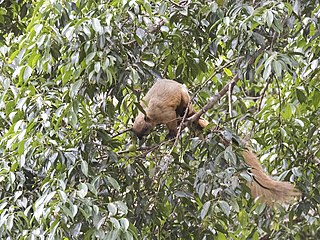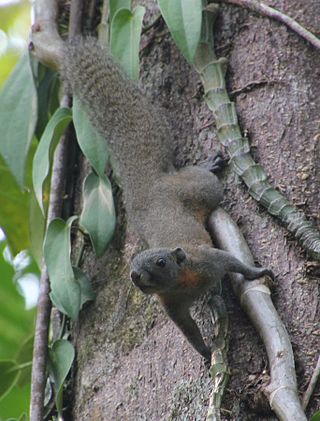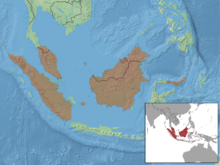
Callosciurus is a genus of squirrels collectively referred to as the "beautiful squirrels". They are found mainly in Southeast Asia, though a few species also occur in Nepal, northeastern India, Bangladesh and southern China. Several of the species have settled on islands. In total, the genus contains 15 species and numerous varieties and subspecies. The genera Glyphotes, Rubrisciurus, and Tamiops have sometimes been included in Callosciurus.

The red giant flying squirrel or common giant flying squirrel is a species of rodent in the family Sciuridae (squirrels). It is found in a wide variety of forest–types, plantations and more open habitats with scattered trees in Southeast Asia, ranging north to the Himalayas and southern and central China. One of the largest arboreal squirrels, all populations have at least some reddish-brown above and pale underparts, but otherwise there are significant geographic variations in the colours. The taxonomic position of those in the Sundaic region is generally agreed upon, but there is considerable uncertainty about the others, which variously have been included in this or other species, or recognized as their own species.

The black hornbill is a species of bird of the hornbill family Bucerotidae. It lives in Asia in Brunei Darussalam, Indonesia, Malaysia, Singapore, Thailand.

The white-fronted surili is a species of primate in the family Cercopithecidae, the Old World monkeys. It is endemic to the large international island of Borneo, in Indonesia, Malaysia, and possibly Brunei.

The grey-bellied squirrel is a species of rodent in the family Sciuridae. It is found in forests, plantations and gardens in Peninsular Malaysia, Thailand, southern Myanmar, southern China (Yunnan) and possibly western Laos. It has been introduced in the Ryukyu Islands in Japan. As suggested by its name, its belly is usually grey, though sometimes reddish on the sides. Depending on subspecies and season, the upperparts are grey, yellowish-olive or reddish.

Finlayson's squirrel or the variable squirrel is a species of rodent in the family Sciuridae. It is found in Cambodia, Laos, Myanmar, Thailand, and Vietnam. The species occurs in a wide range of wooded habitats, including gardens and parks in cities like Bangkok. It was named in honour of the Scottish naturalist and traveller George Finlayson.

The Mentawai squirrel is a species of rodent in the family Sciuridae. It is one of 20 or so species endemic to the Mentawai Islands off the west coast of Sumatra. There are three subspecies: C. m. melanogaster, C. m. mentawi, and C. m. atratus. This small isolated population is listed as "Vulnerable" by the IUCN due to habitat loss.

The black-striped squirrel is a species of rodent in the family Sciuridae. It is found throughout Java, Sumatra, southern Thailand, the Malay Peninsula, and numerous small islands. This taxon consists of four subspecies: C. n. nigrovittatus, C. n. bilimitatus, C. n. bocki, and C. n. klossi. It is listed as "least concern" by the IUCN.

The plantain squirrel, oriental squirrel or tricoloured squirrel is a species of rodent in the family Sciuridae found in Indonesia, Malaysia, Singapore, and Thailand in a wide range of habitats: forests, mangroves, parks, gardens, and agricultural areas. Fruit farmers consider them to be pests.

The Borneo black-banded squirrel is a species of rodent in the family Sciuridae. It is endemic to northern Borneo.

The Irrawaddy squirrel or hoary-bellied Himalayan squirrel is a species of rodent in the family Sciuridae.

The spotted giant flying squirrel, also known as the lesser giant flying squirrel, is a species of rodent in the family Sciuridae. It is found in hill and mountain forests at altitudes of 200–4,000 m (660–13,120 ft) in Southeast Asia north to central China and the east Himalayan region, although the northern populations sometimes are regarded as separate species as the grey-headed giant flying squirrel, Chindwin giant flying squirrel and P. marica. Two of these, as well as a few other populations, lack the white spots on the upperparts for which it is named. Although a large flying squirrel, it is a relatively small giant flying squirrel.

The cream-coloured giant squirrel or pale giant squirrel is a large tree squirrel in the genus Ratufa found in forests in the Thai-Malay Peninsula, Sumatra (Indonesia), Borneo and nearby small islands. The species is near threatened and vulnerable to habitat degradation, and it has probably been extirpated in Singapore where the last sighting was in 1995. Reported sightings in Vietnam in 1984 are considered to be dubious.

The black giant squirrel or Malayan giant squirrel is a large tree squirrel in the genus Ratufa native to the Indomalayan zootope. It is found in forests from northern Bangladesh, northeast India, eastern Nepal, Bhutan, southern China, Myanmar, Laos, Thailand, West Malaysia, Cambodia, Vietnam, and western Indonesia.

The horse-tailed squirrel is a species of rodent in the family Sciuridae. It is found throughout the islands of Borneo and Sumatra, as well as the southern half of the Malay Peninsula, which includes the entire nations of Brunei and Malaysia, as well as some areas of Indonesia and Thailand. There was a mention of this squirrel being found in Vietnam in 1831, but subsequent descriptions of this squirrel's range have not included that nation.
Kloss's squirrel or Kloss squirrel is a species of rodent in the family Sciuridae. It is endemic to northern Sumatra in Indonesia. Population data is insufficient to assess its conservation status according to the IUCN. It is sometimes considered a subspecies of C. notatus.

Durio graveolens, sometimes called the red-fleshed durian, orange-fleshed durian, or yellow durian, is a species of tree in the family Malvaceae. It is one of six species of durian named by Italian naturalist Odoardo Beccari. The specific epithet graveolens is due to the odor. Although most species of Durio have a strong scent, the red-fleshed type of D. graveolens has a mild scent. It is native to Southeast Asia.

Durio oxleyanus is a perennial plant species of tree in the family Malvaceae. It was once placed in the family Bombacaceae.






















